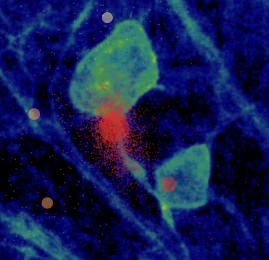Update: 22 Oct 2021
This is the latest version 0.3.99, which introduces compatbility with SpikeInterface version 0.90+ (note version 0.10 is no longer supported). SpikeInterface wraps many spike sorters, can read almost any file format and contains other useful functionality into a single code base. We will soon transition to a version of Herding Spikes that fully integrates with SpikeInterface. The example notebooks in this repository illustrate the main HS2 functionality, but do not run at the moment as the data links have become stale.
This software provides functionality for the detection, localisation and clustering of spike data from dense multielectrode arrays based on the methods described in the following papers:
J.-O. Muthmann, H. Amin, E. Sernagor, A. Maccione, D. Panas, L. Berdondini, U.S. Bhalla, M.H. Hennig MH (2015). Spike detection for large neural populations using high density multielectrode arrays. Front. Neuroinform. 9:28. doi: 10.3389/fninf.2015.00028.
G. Hilgen, M. Sorbaro, S. Pirmoradian, J.-O. Muthmann, I. Kepiro, S. Ullo, C. Juarez Ramirez, A. Puente Encinas, A. Maccione, L. Berdondini, V. Murino, D. Sona, F. Cella Zanacchi, E. Sernagor, M.H. Hennig (2016). Unsupervised spike sorting for large scale, high density multielectrode arrays. Cell Reports 18, 2521–2532. bioRxiv: http://dx.doi.org/10.1101/048645.
This implementation is highly efficient, spike detection and localisation runs in real time on recordings from 4,096 channels at 7kHz on a desktop PC. Large recordings with millions of events can be sorted in minutes.
Since we believe publicly funded research code should be free and open, all code is released under GPL-3.0.
- 3Brain BIOCAM and BIOCAM X
- Neuropixel array
- ETH MEA1K
- any data formast supported by SpikeInterface
- Matthias Hennig: Spike sorting
- Jano Horvath: Parameter optimisation
- Cole Hurwitz: Spike detection, localisation and sorting, C++ code
- Oliver Muthmann: Spike detection and localisation
- Albert Puente Encinas: C++ implementation, optimisation and parallelisation
- Martino Sorbaro: Spike sorting, class structure and much of the python code
- Cesar Juarez Ramirez: Visualisation
- Raimon Wintzer: GUI and visualisation
The code has been tested with Python version 3.6. It is essential numpy is available before installing.
The other dependencies will be installed by the installer.
If your system does not have Python pre-installed, the Anaconda distribution may be used.
We suggest you use Anaconda if you don't have a favourite Python installed yet. We also recommend installing the code in a virtual environment (see below in the "from source" sections).
A pip distribution is available and can be installed as follows:
pip install numpy scipy
pip install herdingspikes
Note: HerdingSpikes is tested on Python 3.5 and above. It may work on Python 3.0-3.4.
To install from source, clone this repository and follow the instructions below.
We suggest you install the code in a virtual environment. You can create one by running
python3 -m venv --system-site-packages desired/location/HS2venv
source desired/location/HS2venv/bin/activate
You can omit --system-site-packages if you don't want to use the local versions of common Python libraries. You will need to activate whenever you're using the module.
The module can automatically be installed, including all dependencies, by running
pip install numpy scipy
python setup.py install
Once Anaconda is installed, create and activate a virtual environment called HS2env. This can be done with the Anaconda Navigator per mouse click. To make sure numpy and Cython are available, type
conda install -n C:\Users\HS2env numpy
Alternatively, open the Anaconda Prompt and type:
conda search "^python$"
This will display a list of available python versions. Here we choose 3.6.5:
conda create -n C:\Users\HS2env python=3.6.5 anaconda
This environment should be activated every time HS2 is used with the command
conda activate C:\Users\HS2env
To make sure numpy is available, type
conda install -n C:\Users\HS2env numpy
HS2 contains fast C++ code, which requires a compiler. If you don't have a C++ compiler installed, the easiest solution is to download and install the Microsoft Visual Studio Build Tools: https://www.visualstudio.com/downloads/#build-tools-for-visual-studio-2017.
Either download and uncompress: https://github.com/mhhennig/HS2/archive/master.zip
Or install git from https://git-scm.com/download/win. Then open a command prompt and type
git clone https://github.com/mhhennig/HS2.git
This will create a folder HS2 in the current directory. Note that updates can now be simply retrieved by typing git pull.
To install, go to the HS2 directory, e.g.
cd HS2
and type
python setup.py install
Now HS2 will be available in the current virtual environment.
Example code for the different supported systems is in the folder notebooks. These can be run without installing HS2 system-wide, but requires to run python setup.py build_ext --inplace in the HS2 directory. Next, run jupyter notebook and navigate to the directory to try the code. Each notebook will download a short segment of raw data.
Go here for documentation. A worked example for Biocam data is here.
The herders are based at the School of Informatics, University of Edinburgh. Contact us here, we are happy to help.

